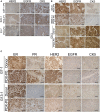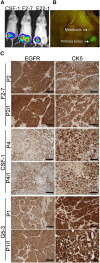Development of Novel Patient-Derived Xenografts from Breast Cancer Brain Metastases
- PMID: 29164052
- PMCID: PMC5673842
- DOI: 10.3389/fonc.2017.00252
Development of Novel Patient-Derived Xenografts from Breast Cancer Brain Metastases
Abstract
Brain metastases are an increasing burden among breast cancer patients, particularly for those with HER2+ and triple negative (TN) subtypes. Mechanistic insight into the pathophysiology of brain metastases and preclinical validation of therapies has relied almost exclusively on intracardiac injection of brain-homing cells derived from highly aggressive TN MDA-MB-231 and HER2+ BT474 breast cancer cell lines. Yet, these well characterized models are far from representing the tumor heterogeneity observed clinically and, due to their fast progression in vivo, their suitability to validate therapies for established brain metastasis remains limited. The goal of this study was to develop and characterize novel human brain metastasis breast cancer patient-derived xenografts (BM-PDXs) to study the biology of brain metastasis and to serve as tools for testing novel therapeutic approaches. We obtained freshly resected brain metastases from consenting donors with breast cancer. Tissue was immediately implanted in the mammary fat pad of female immunocompromised mice and expanded as BM-PDXs. Brain metastases from 3/4 (75%) TN, 1/1 (100%) estrogen receptor positive (ER+), and 5/9 (55.5%) HER2+ clinical subtypes were established as transplantable BM-PDXs. To facilitate tracking of metastatic dissemination using BM-PDXs, we labeled PDX-dissociated cells with EGFP-luciferase followed by reimplantation in mice, and generated a BM-derived cell line (F2-7). Immunohistologic analyses demonstrated that parental and labeled BM-PDXs retained expression of critical clinical markers such as ER, progesterone receptor, epidermal growth factor receptor, HER2, and the basal cell marker cytokeratin 5. Similarly, RNA sequencing analysis showed clustering of parental, labeled BM-PDXs and their corresponding cell line derivative. Intracardiac injection of dissociated cells from BM-E22-1, resulted in magnetic resonance imaging-detectable macrometastases in 4/8 (50%) and micrometastases (8/8) (100%) mice, suggesting that BM-PDXs remain capable of colonizing the brain at high frequencies. Brain metastases developed 8-12 weeks after ic injection, located to the brain parenchyma, grew around blood vessels, and elicited astroglia activation characteristic of breast cancer brain metastasis. These novel BM-PDXs represent heterogeneous and clinically relevant models to study mechanisms of brain metastatic colonization, with the added benefit of a slower progression rate that makes them suitable for preclinical testing of drugs in therapeutic settings.
Keywords: HER2+; brain colonization; brain metastases models; breast cancer; patient-derived xenograft; triple negative.
Figures







Similar articles
-
Estrogen promotes the brain metastatic colonization of triple negative breast cancer cells via an astrocyte-mediated paracrine mechanism.Oncogene. 2016 Jun 2;35(22):2881-92. doi: 10.1038/onc.2015.353. Epub 2015 Sep 28. Oncogene. 2016. PMID: 26411365 Free PMC article.
-
Development of clinically relevant in vivo metastasis models using human bone discs and breast cancer patient-derived xenografts.Breast Cancer Res. 2019 Nov 29;21(1):130. doi: 10.1186/s13058-019-1220-2. Breast Cancer Res. 2019. PMID: 31783893 Free PMC article.
-
Luminal breast cancer metastases and tumor arousal from dormancy are promoted by direct actions of estradiol and progesterone on the malignant cells.Breast Cancer Res. 2014 Dec 5;16(6):489. doi: 10.1186/s13058-014-0489-4. Breast Cancer Res. 2014. PMID: 25475897 Free PMC article.
-
Patient-derived xenograft models of breast cancer and their predictive power.Breast Cancer Res. 2015 Feb 10;17(1):17. doi: 10.1186/s13058-015-0523-1. Breast Cancer Res. 2015. PMID: 25849559 Free PMC article. Review.
-
Management of breast cancer brain metastases: Focus on human epidermal growth factor receptor 2-positive breast cancer.Chronic Dis Transl Med. 2017 Mar 8;3(1):21-32. doi: 10.1016/j.cdtm.2017.01.004. eCollection 2017 Mar 25. Chronic Dis Transl Med. 2017. PMID: 29063053 Free PMC article. Review.
Cited by
-
Novel Breast Cancer Brain Metastasis Patient-Derived Orthotopic Xenograft Model for Preclinical Studies.Cancers (Basel). 2020 Feb 14;12(2):444. doi: 10.3390/cancers12020444. Cancers (Basel). 2020. PMID: 32074948 Free PMC article.
-
In vivo selection of the MDA-MB-231br/eGFP cancer cell line to obtain a clinically relevant rat model for triple negative breast cancer brain metastasis.PLoS One. 2020 Dec 2;15(12):e0243156. doi: 10.1371/journal.pone.0243156. eCollection 2020. PLoS One. 2020. PMID: 33264355 Free PMC article.
-
Brain Metastasis Cell Lines Panel: A Public Resource of Organotropic Cell Lines.Cancer Res. 2020 Oct 15;80(20):4314-4323. doi: 10.1158/0008-5472.CAN-20-0291. Epub 2020 Jul 8. Cancer Res. 2020. PMID: 32641416 Free PMC article. Review.
-
Microglia and metastases to the central nervous system: victim, ravager, or something else?J Exp Clin Cancer Res. 2022 Nov 21;41(1):327. doi: 10.1186/s13046-022-02535-7. J Exp Clin Cancer Res. 2022. PMID: 36411434 Free PMC article. Review.
-
Preclinical Models of Brain Metastases in Breast Cancer.Biomedicines. 2022 Mar 13;10(3):667. doi: 10.3390/biomedicines10030667. Biomedicines. 2022. PMID: 35327469 Free PMC article. Review.
References
Grants and funding
LinkOut - more resources
Full Text Sources
Other Literature Sources
Molecular Biology Databases
Research Materials
Miscellaneous

